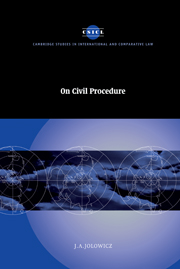Book contents
- Frontmatter
- Contents
- Preface
- List of abbreviations
- Introduction
- I The litigation process
- 1 Civil litigation
- 2 Some twentieth-century developments in Anglo-American civil procedure
- 3 On the nature and purposes of civil procedural law
- 4 The dilemmas of civil litigation
- II Protection of diffuse, fragmented and collective interests
- III Procedural modes
- IV The parties and the judge
- V Recourse against judgments
- VI Procedural reform
- Index
- CAMBRIDGE STUIDES IN INTERNATIONAL AND COMPARATIVE LAW
4 - The dilemmas of civil litigation
from I - The litigation process
Published online by Cambridge University Press: 18 December 2009
- Frontmatter
- Contents
- Preface
- List of abbreviations
- Introduction
- I The litigation process
- 1 Civil litigation
- 2 Some twentieth-century developments in Anglo-American civil procedure
- 3 On the nature and purposes of civil procedural law
- 4 The dilemmas of civil litigation
- II Protection of diffuse, fragmented and collective interests
- III Procedural modes
- IV The parties and the judge
- V Recourse against judgments
- VI Procedural reform
- Index
- CAMBRIDGE STUIDES IN INTERNATIONAL AND COMPARATIVE LAW
Summary
Action and right
In a famous passage in the Institutes of Justinian, the ‘action’ is denned as ‘nothing other than the right of pursuing in judicio that which is due to one’, and when it eventually became necessary for European lawyers to find a link between the substantive law which had for so long been studied in the universities, on the one hand, and the procedures of the courts, on the other, it was natural for them to turn to that. The action became ‘the law in motion’, the ‘law in a state of war’ or, in the less exciting but more precise language of Glasson and Tissier's treatise on French civil procedure ‘the action is the power which a person possessed of a right has of obtaining from a judge the protection of that right’. In other words - and the words were used - if there is no right, there is no action.
In England the starting point was different, for in England, so far as proceedings in the royal courts were concerned, the formulary system of the forms of action was the basis of the law for centuries. Substantive law, as such, could not really be said to exist: only if a writ and a form of action adapted to his case was available to a would-be plaintiff could he invoke the jurisdiction of the king's courts at all. What is more, even if a suitable form of action existed, if the plaintiff had mistakenly used not that form but a different one, his claim would fail.
- Type
- Chapter
- Information
- On Civil Procedure , pp. 81 - 94Publisher: Cambridge University PressPrint publication year: 2000



